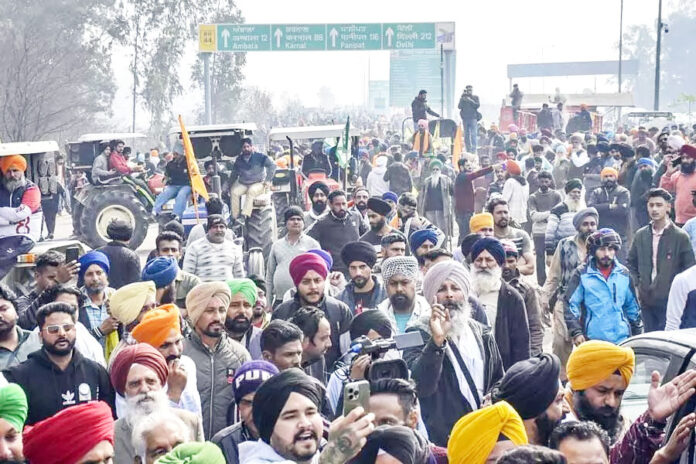DOGRA HERALD BUREAU
CHANDIGARH/NEW DELHI
Farmers from Punjab faced tear gas shells – some of them dropped by a drone — at two border points as protesters tried to break past barricades set up by the Haryana Police to stop them from heading to the national capital.
Police hurled tear gas shells, and the protesters hurled stones, at the Shambhu border near Ambala in Haryana. Tear gas was also used against protesters at the border between the two states in Haryana’s Jind district.
Near Shambhu, the stand-off between the protesters and the police continued for hours as the area filled up with tear gas smoke. Some protesters were detained by the Haryana Police, sources said.
The Samyukta Kisan Morcha (Non-Political) and the Kisan Mazdoor Morcha are spearheading the `Delhi Chalo’ agitation to put pressure on the Centre for their demands, including a law on minimum support price for crops and loan waivers.
A large group of farmers, including women, packed in tractor-trolleys and other vehicles left at about 10 am from Punjab’s Fatehgarh Sahib, about 40 km from the border with BJP-ruled Haryana.
An excavator was a part of one convoy, with a farmer in Amritsar saying it would be used to break barricades.
Police barriers have been put up at several places in Haryana on the highway to Delhi.
At major entry points to the capital, the Delhi Police has installed layers of similar barriers that include barbed wire, concrete slabs and tyre-bursting strips on the road.
The “fortification” of Delhi’s borders reminded many of the farmers’ agitation for the repeal of the Centre’s agri-marketing laws in 2021. The protesters had then blockaded the main roads leading into Delhi for months.
On Monday, marathon talks in Chandigarh between farmer leaders and two Union ministers failed to arrive at an agreement.
The ‘Delhi Chalo’ march met its first roadblock at Shambhu.
Security personnel deployed on the Haryana side asked a group of youths to stay away from the barricades.
They first used tear gas when some protesters broke a metal barricade and tried to throw it off the Ghaggar river bridge.
Protesters also used tractors, trying to shift heavy concrete barriers. Many of them dispersed into the fields adjoining the highway, apparently to circumvent the roadblock. They too faced tear gas shells.
Protesters were seen covering tear gas shells as they landed on the ground with jute bags to contain the smoke.
A drone was seen dropping shells over the crowd of protesters.
A Haryana Police spokesperson said tear gas was used to control the situation when stones were pelted at police personnel.
“No one will be allowed to create a disturbance. Those doing so will be dealt with strictly,” the spokesperson said.
Authorities in Haryana have fortified the state’s borders with Punjab at places in Ambala, Jind, Fatehabad, Kurukshetra and Sirsa to scuttle the march.
Riot control vehicles, including water cannons, are stationed at several places. Drones are being used to keep an eye on the protesters.
At another face-off, police lobbed teargas shells and used water cannons at the main border point in Jind. The farmers were trying to cross barricades installed at Data Singhwala-Khanauri border.
A protester was injured, farmers said.
The Haryana government has imposed restrictions on the assembly of people under section 144 of the Criminal Procedure Code (CrPC) in 15 districts.
Kisan Mazdoor Sangharsh Committee leader Sarwan Singh Pandher on Tuesday slammed the heavy barricading on the road to Delhi.
“It does not seem Punjab and Haryana are two states. It seems they have an international border,” he told reporters at Fatehgarh Sahib before the march began.
Lashing out at the Manohar Lal Khattar government, Pandher said Haryana has been turned into “Kashmir Valley.”
In Haryana, 64 companies of paramilitary personnel and 50 from the state police were deployed across the districts.
“We will not indulge in any confrontation with the government. The government may fire bullets or lathi-charge us. Jawans of police and paramilitary forces are also our brothers,” Pandher had said, claiming that their march would be peaceful.
Following a second round of meeting that lasted more than five hours with the Centre late on Monday, he said, “We do not think the government is serious about any of our demands. We do not think they want to fulfil our demands.”
However, Union Agriculture Minister Arjun Munda, who, along with Union Food and Consumer Affairs Minister Piyush Goyal, took part in the Chandigarh talks, said a consensus was reached on most issues.
A formula was proposed for resolving some others issues after forming a committee, he said.
“We are still hopeful that farmer bodies will hold talks. We will try to resolve issues in the coming days,” Munda said after the Monday meeting.



























